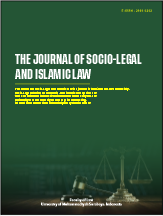The Legitimacy of Unmanned Aerial Vehicle Usage in International Humanitarian Law
DOI:
https://doi.org/10.30651/jssl.v2i2.22382Keywords:
Keywords: Civilian population, Legality and accountability of states, International lawAbstract
The use of drones as a weapon in the battlefield has raised various issues, especially concerning the protection of civilian populations and compliance with the principles of IHL (International Humanitarian Law). Although there are no specific international regulations governing the use of drones, flexible principles of IHL can be applied. However, the use of drones for armed attacks has raised questions about the legality and state responsibility for their impact. In the context of the United States, the use of drones has raised concerns regarding violations of IHL and international law. Protecting civilians under IHL and distinguishing between military and non-military targets are primary concerns in assessing the use of drones as weapons. Furthermore, the need for stricter international regulations and state accountability in the use of drones is also highlighted in this article. Thus, this article presents an in-depth analysis of the legal challenges and implications of drone use in wartime situations, as well as emphasizing the need for a clear regulatory framework within the context of international law.
Keywords: Keywords: Civilian population, Legality and accountability of states, International law
References
Chesney Robert M.,” Beyond The Battlefield, Beyond Al Qaeda: The destabilizing legal architecture Of counterterrorism”, Michigan Law Review, Vol.112, No.163;
Declaration on The Inadmissibility of Intervention in The Domestic Affairs of States and The Protection of Their Independence and Sovereignty;
Franke Ulrike Esther, “Drone Strikes, and US Policy: The Politics of Unmanned Aerial Vehicles”, Parameters, Vol 44, No.1, Spring 2014.hlm.121.
Harris D. J., 2004, Cases and Materials on International Law, Sixth Edition, London: Sweet & Maxwell;
Hurlburt Heather, “Battlefield Earth”, Democracy, No.31, Winter 2014, hlm.62. ICRC, “A Guide to the Legal Review of New Weapons, Means and Methods of Warfare: Measures to Implement Article 36 of Additional Protocol I of 1977”, International Review of the Red Cross, Vol.88, No.864, Desember 2006;
Jessup Philip C, 2012, A Modern Law of Nation, (terjemahan), Nuansa, Bandung; Johnson Robert A., “ Predicting Future War”, Parameter, Vol.44, No.1, spring 2014;
Medea Benjamin, 2012, Drone Warefare, Killing By Remote Control, Or Books, New York;
Mcclelland Justin, ” The review of weapons in accordance with Article 36 of Additional Protocol I”, International Review of the Red Cross ,Vol. 85 No 850, Juni 2003;
United Nations, 2008, “Security Council, Resolution 1816 (2008) Adopted by the Security Council at its 5902nd meeting] http://daccess-dds- ny.un.org/doc/UNDOC/GEN/N08/361/77/PDF/N0836177.pdf?OpenElemen t;
US Government Accountability Office , july 2012, “Non-proliferation: Agencies Could Improve Information Sharing and End-Use Monitoring on Unmanned Aerial Vehicle Exports”, http://www.gao.gov/assets/600/593131.pdf;
“Perancis Menyerang Dari Udara dan Darat”, Kompas http://www.internasional.kompas.com/read/2013/01/13/02401043/Perancis.Menyerang.dari.Udara.dan.darat
Downloads
Published
How to Cite
Issue
Section
License
Copyright (c) 2024 L.Ya Esty Pratiwi

This work is licensed under a Creative Commons Attribution 4.0 International License.






